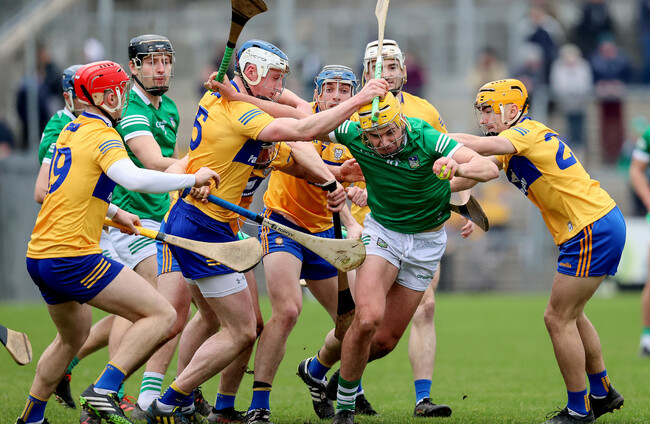IT WAS THE 2012 All-Ireland quarter-final and Limerick star James Ryan was in possession, utterly perplexed by the conduct of Michael Fennelly.
“I can remember having the ball and Michael was in front of me. I was there, ‘why isn’t he coming to me? Why isn’t he coming to me?’ He kept waiting,” he recalled last year during a Limerick hurling workshop on coaching the tackle.
“He was using his attributes. Big, strong, rangy lad. He was waiting for me to throw up the ball or take a solo. He put me, the player with the ball, into a nervousness. He made me make a decision. I wanted him to come towards me so I could take him on. He put me out of my comfort zone by taking a step back. He was focused on the ball.”
Fennelly perfected a principle at the heart of dispossession in hurling. After four steps the ball must be free to be flicked, hooked or blocked. That Kilkenny team were masters of such precision. Who could forget JJ Delaney’s expertly-timed hook of Seamus Callanan in the 2014 All-Ireland final replay?
The problem now is that much of that defensive probing goes on while the ball is still in the opponent’s hand. Immense physical contact is encouraged in training and expected on the field.
No area is more a the discretion of the referee. Congress’s upcoming amendment to the black card so that as a ‘rule of thumb’ it would not apply within 25 metres infield of each side-line merely reinforces that. Meanwhile, players continue to push the boundaries of what is deemed acceptable play.
Ryan is a Games Development Administrator for Limerick. Previously he played hurling and football for his county. The tackle, he explained, is becoming absorbingly similar across both codes.
That comparison has been made before, most notably with the swarm tackle. What started in Gaelic football was adapted by Kilkenny in hurling. Increased athleticism changed the dynamic. The middle third is now a sea of collisions and rucks. A moment’s hesitation carries with it the risk of being washed away.
Better use of possession including short or recycled passing limit the opportunity for hooks and blocks. Now it is all about hits, with the hurley or the body. Much of this is prohibited in the rule book but players expect it and referees allow it. Every team has embraced this new reality. Individual and team tackling has been redefined.
In last year’s championship, Limerick scored 2-33 from their own puck-out and 0-18 directly from the opposition’s. The majority of their scores came from turnovers, a seismic 6-57. Their tackle targets are put up on the dressing room wall, but that’s not a template easily duplicated.
Before you master the tackle, you need to properly understand it.
One for a debate.@OfficialWexGAA had 15 tackles to @GaaClare 11 tackles after 15 minutes in today's game.
— Sean Flynn (@hurlingtalk1) July 17, 2021
Score Clare 1-8 to Wexford's 0-2.
The narrative often spread "whoever tackles more will win the game".
A narrative that needs to be challenged?@sheikhbarabas pic.twitter.com/bpB4oxl3Lp
“We’ve done tackling work and got feedback from high-level players who said they were never shown how to actually tackle,” explains Sean Flynn. He is a hurling coach and worked as an analyst for Tipperary in their 2019 All-Ireland winning season.
“What is the point in having a young lad chasing a number of tackles when he doesn’t know how to do it?
“If you have targets, I often find you have lads running around trying to rack them up regardless of effectiveness. It is like a lad with a GPS number chasing.
“Too many hide behind tackle numbers rather than focusing on technique.”
Rather than raking up numbers, it is about what teams want from the tackle. Was there any impact on possession? This could be directly with a turnover, or indirectly by forcing an opponent into a quick decision and an inaccurate pass/shot. What about an opponent’s velocity or direction?
The desired destination is only a small step. The key is how to get there.
Alongside Ryan during that workshop was former Limerick hurler and fellow GDA Paul Browne. When discussing coaching the tackle, he pointed to American football and linesmen. The similarities are striking. Both are about stopping players from passing you. Both outlaw pushing in the back, grabbing, low or high hits.
The hand and feet movements are alike; hips must be aligned. Specific drills exist to stress the importance of technique and are applicable across sports.
For the "you hate on ladders but offer no solutions" crew...
— Rugby Strength Coach (@RUGBY_STR_COACH) July 16, 2019
Station from today's lineman agility circuit/combative work. O must shutdown space, D must create separation with footwork and misdirection.
Vision-decision-action, competition, intensity, biomechanical relevance ✔️ pic.twitter.com/5mzzRKrNFY
Tallies cover the what, but the best use them to enhance the how and why. During last year’s league, the free-hand tackle was the most common foul awarded. As a result, some coaches had their players tackle with a tennis ball in one hand.
“You need to look at the outcome,” stresses Flynn.
“You can hand a hurley to someone who has never hurled before and they could go out and rack up a big tackle number. At the same time, they could have no impact on the game. It is the quality of the tackle that counts.”



